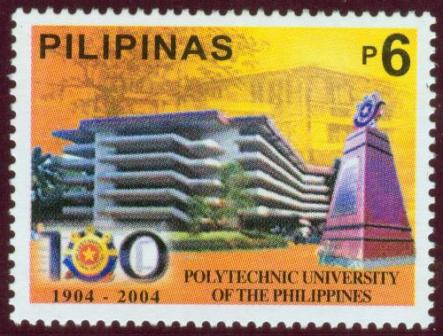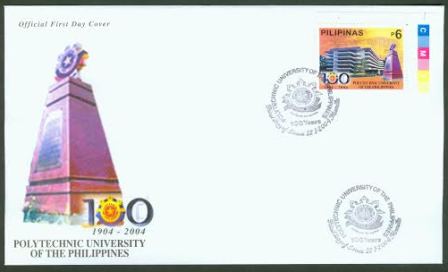2004, January 22. Polytechnic University of the Philippines Centennial
Litho Offset. Amstar Company, Inc., Perf. 14.
Singles, Sheets of 50

6p Polytechnic University Building - Singles (150,000)
Layout Artists: Prof. Jessica Buan-Dalit, Alfonso V. Divina
Design Coordinator: Ms. Lota Munsayac-Rubi
Graphic Designer: Archt. Gloria B. Teodoro
Design: The PUP MAIN BUILDING - PUP Mabini Campus is now a vibrant compound of almost 20 hectares of land that features facilities fit for a pleasant academic pursuit. The original building, previously intend to be a two-story tenement housing project, has now risen to a fourwing and six-story main building complimenting the enchanced campus environment. The complex speaks of the university's potential to expand, renovate, and build on a grander scale. The OLD LEPANTO BUILDING - the first school building bearing witness to PUP's origin as a small clerical school. CENTENNIAL MONUMENT - symbolizes the commemoration of 100th Foundation. The CENTENNIAL LOGO - is an emblem of noble and glorious past, a living testimony to the University population's adherence to the beautiful traits of loyalty, integrity, love of peace, commitment to service, and undying love of and devotion to God - essential attributes in the pursuit of academic excellence and progress in the span of one hundred years, 1904-2004.
First Day Covers: Manila
Polytechnic University of the Philippines - 100th Anniversary
The Polytechnic University of the Philippines (PUP) traces its roots back to 1904 when it was merely a fledgling vocational school called the Manila Business School located in the crowded alleys of Lepanto Street (now S.H. Loyola), Sampaloc, Manila. After four years, it was renamed Philippine School of Commerce. In 1952, its name was again changed to Philippine College of Commerce until its conversion to university status in April 1978 when it was given its present name, the Polytechnic University of the Philippines.
The PUP Lepanto Building still stands today where vocational and technopreneurial non-degree courses are offered. The building is a testimony of PUP's origin as a small clerical school. The inception of the institution was borne out of the need to provide manpower to an emerging country that was starting to build its government bureaucracy and to industry engaged in commerce. Thus, course programs were intended to produce clerks, bookeepers, and other personnel to do "routine" work in government and business firms.
Over the last 100 years, PUP has grown into one of the country's leading state universities. It is nationally acknowledged as a pioneer in vocational and business education and a leader in polytechnic education. It is also referred to as the "people's university", catering to economically challenged yet deserving students. It is recognized for its commitment to strong nationalist yet humanist orientation. Its robust student population--reaching about 50,000 in-campus and off-campus students--is the largest across the country. Academic offerings have grown considerably into nine (9) technopreneurial courses, seventy-two (72) bachelors' degrees, fifteen (15) masters' degrees and two (2) postgraduate degrees.
Quality education is evident in PUP's national ranking of academic programs based on performance of its graduates in licensure examinations. Improvements in ranking were registered in the fields of Accountancy, Architecture, Chemistry, Education, Electronics and Communications Engingeering, Mechanical Engineering and Nutrition and Dietetics. Citations were also received for havirxjthe most number of accredited and re-accredited Level II programs. It is now a dualmode institution offering both traditional classroom-based education and distance education. With its meager budget yet comprehensive endeavor, the institution was acknowledged by the Department of Budget and Management as one of the most costeffective State Universities and Colleges in the country in fiscal year 2002. To date, PUP has contributed to the educational, social and economic well-being of hundreds of thousands of excellent students and quality graduates now fueling the country's workforce.
-
Schools & Universities
